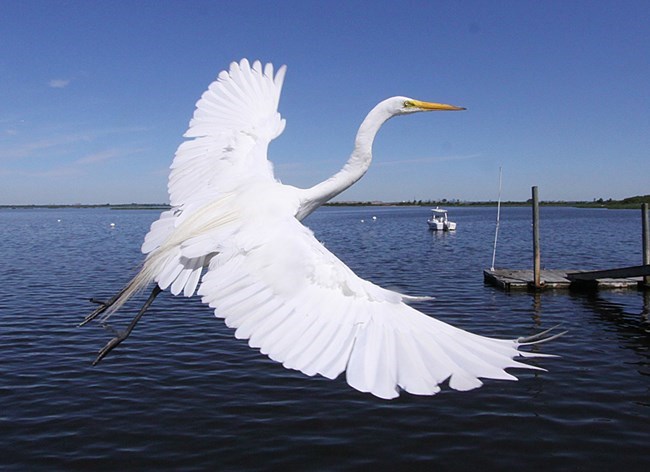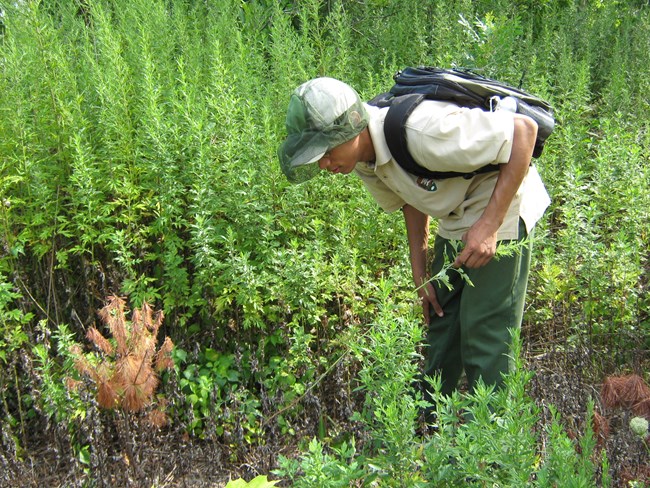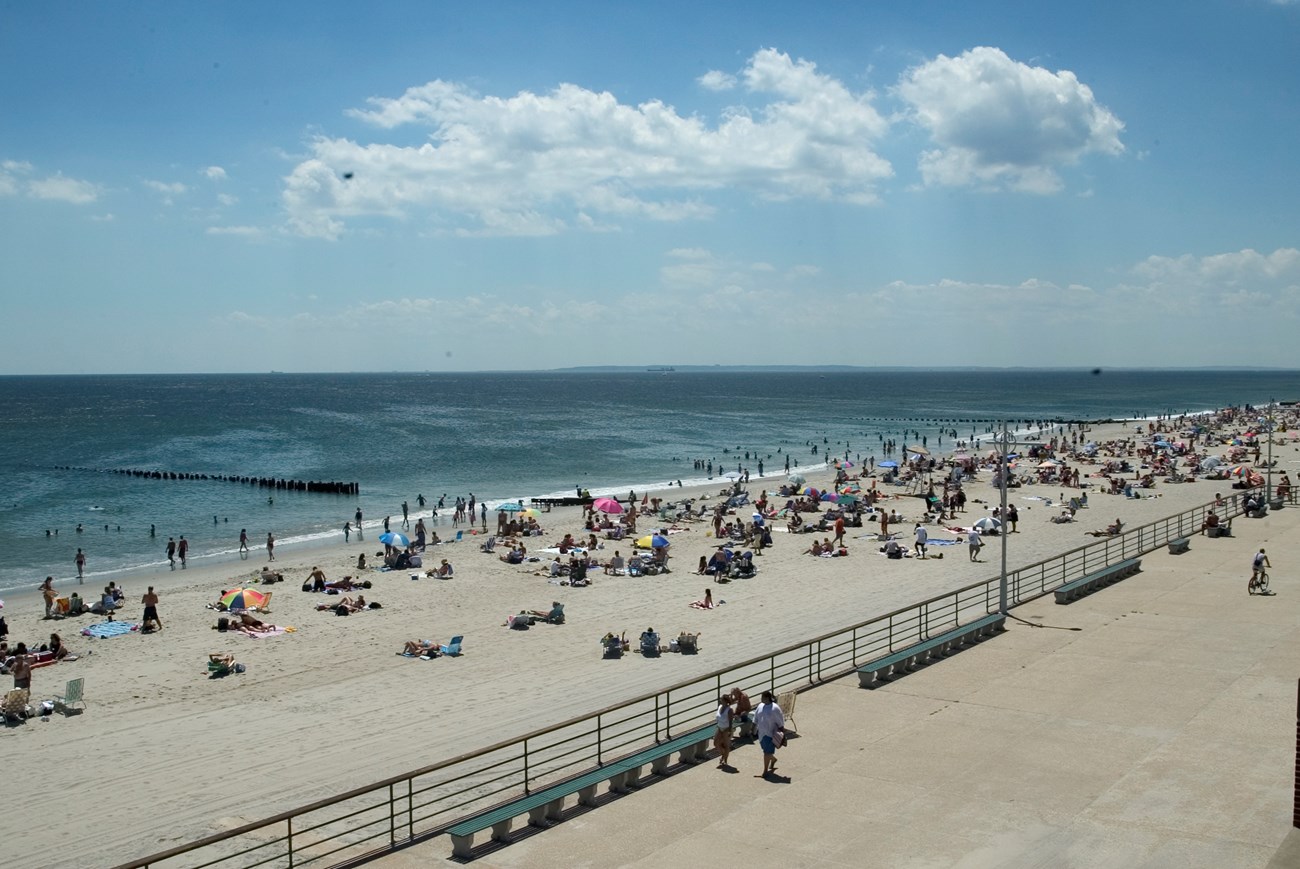
NPS / Konrad Wisniewski
"[W]e need people valuing us, understanding us, supporting us, from every place. ... It’s a hot day. Don’t worry. The parks are open."
Listen
-
Episode Six: The Urban Parks Mission
In conversation with Ed Rizzotto. How have national parks served as places of social reform?
- Credit / Author:
- NPS
- Date created:
- 03/13/2020
The Urban Parks Mission
ED RIZZOTTO (narrator): When I was first there, one of the staff referred to one of the students as “emancipated.” And I thought it was a racial pejorative.
LU ANN JONES (host): When Ed Rizzotto joined the National Park Service in the mid-1960’s, the country was at a crossroads.
RIZZOTTO: Because the only time I’d heard “emancipated” was in terms of slaves after the Civil War. It turns out it’s quite a specific term. These were kids who’d been picked up and been brought into court at the age of 16 or 17. They weren’t legally adults. But the judges had looked around and their parents were in jail, dead, drugs, whatever. They declared these kids at 16 or 17 legally responsible for themselves because they had no one else in the world.
We would find them and bring them back in. I mean, they literally came with the clothes on their back. And we’d get them through high school. We’d get them clothing.
JONES: Just two years earlier, Martin Luther King, Jr. had led 250,000 people to the steps of the Lincoln Memorial, demanding civil and economic rights for African Americans. All across the country, people were waking up to social inequities in America. And many felt called to respond -- including George Hartzog, then-director of the National Park Service.

NPS
"What higher purpose can a national park serve," he asked, "than to be responsive to the crisis in our society, to the voice of the underprivileged, to the voice of the protester who's objecting to the institutional status quo?"
Question was: How could the Service address the changing needs of the population, when most of the big, iconic parks were hundreds of miles from the nearest cities?
The answer? Establish new parks -- where people actually lived.
I’m National Park Service historian, Lu Ann Jones. And you’re listening to “A Sense of Place: Stories of Stewardship from the National Park Service.” In this series, we’re diving into the oral history archives to bring you the stories of the people who shaped the parks and the Service.
Today: the urban parks mission.
In 1972 Congress created two parks to serve city residents: Golden Gate National Recreation Area in San Francisco, and Gateway National Recreation Area in New York City. That’s where Ed Rizzotto held several positions from 1988 to 1994.
RIZZOTTO: Gateway was a unique experience. It was trying to do Park Service stuff for people in a big urban area who are never going to see the Park Service any other way. I mean, there’s people in New York who never leave the city. Never drive.
JONES: For those urban New Yorkers, Gateway certainly delivered on the national park promise.
RIZZOTTO: We had a wonderful national wildlife refuge there, which you can reach on a subway line. The A Train goes to Jamaica Bay National Wildlife Refuge, which is part of the park. If you’re a birder, you can go there and build your life list like crazy. In a good year, we might have 400 species of birds in the park. Some of which were there all the time.
There’s a lot of things you can do in New York only at Gateway. Like camping. Like horseback riding in a natural area. A lot of the salt water beaches. The park meant a lot to people.
JONES: The rangers at Gateway offered much more than outdoor adventure and world class birding.
They wanted the parks to feel relevant to the community, to design programs that addressed the needs and struggles of people in the surrounding boroughs. And that meant offering job training and education to youth, helping them learn skills that they could turn into work that paid well.

NPS
RIZZOTTO: When I first came there, the Park Service and the Department of Labor put their money together to run a training school that was within the park.
We were training restoration technicians--carpenters, bricklayers, and people who are in restoration masonry. And the way I describe that is, if you had an old house, that should have had four gargoyles--do you know what a gargoyle is?--and your old house only had three gargoyles, my kids and their instructors could copy one of the gargoyles and make you the fourth corner of the house.
So, they did very high trade stuff. We had great instructors. The original intent of the program was, they would become preservation people in the Park Service.
JONES: The program was called Job Corps. Originally established in 1964 as part of the War on Poverty, Job Corps has gone through many changes over the years. What made it different, though, was its approach to poverty, which was a problem of environmental and economic circumstances. The Gateway Job Corps program offered surrounding youth a comprehensive set of services that included health care, nutrition, social work, and the arts. Students completed a general education diploma and they learned a career skill.
During Rizzotto’s stint as director of the Gateway Job Corps Civilian Conservation Center, the NPS hosted roughly 125 students at a time. Job Corps gave them room and board and 24/7 programming, completely free of charge – which was critical, because many of the students were extremely poor. Some were even homeless.
RIZZOTTO: I remember one time I was counseling one of our tough kids. He thought he was going to be expelled. He wasn’t going to be expelled. But he started crying. I wasn’t being tough with him. He just was sad. He had come in sad. But you saw kids, these were out of the Bronx. These were tough kids.
And I said, “Gee, what’s going on?”
He said, “Are you going to expel me?”
Here was a kid who was homeless. His mother and baby sister were homeless, too. They were living in a shelter somewhere. And the three of them were counting on him graduating, getting a job, and then they would have an apartment. They would all be off the street and could live as a family again. He was like 17 years old.
JONES: Everyone knows national parks as places to hike, learn history, observe wildlife. But national parks as sites of vocational training? Of social reform?
RIZZOTTO: People would criticize us. That’s why I mentioned, it wasn’t that expensive. The whole deal, including clothes for these kids, work clothes and relaxing clothes, was almost $15,000 a year. But at the same moment, across town, their peers were at a place called Rikers Island. You know what that is? It’s a juvenile facility, and that was costing the city 42 grand a year. So, I just said, just in the taxes we’re saving you, and then when they get jobs, they’re paying it back. This is a no brainer.
Cause people saw it like, what are you doing--this is a social thing. We were doing good things for lots of people. It was a program I felt really--I felt good about a lot of these Park Service things. I felt good about that. And those kids are probably still out restoring buildings, for all I know. Maybe they’re contracting. Ellis Island is being fixed now, maybe they’re there. They’re old enough so they’re probably be training other people. Maybe other kids are there. I don't know, but it was a pretty cool thing.

NPS
JONES: For many of the rangers in the National Park Service, stewardship is more of a calling than a job. But this may be especially true for urban rangers. Rangers like Rizzotto, for whom each day presented new opportunities to change the social landscape of the community -- not just through programming, but through small gestures of humanity and service that bonded the people to the park -- and even saved lives.
RIZZOTTO: Riis Park is a big ocean beach that the Park Service runs down there. It’s a historic structure, all restored, but a big waterfront.
When it was very hot, a lot of people would come down from what we would call tenements. The upper part of the city had old, old, nasty housing that typically didn’t have any air conditioning. You’re living in little boxes, not even necessarily with air shafts. They’d come down to the park for the day, normally closing at sunset. But we let them stay.
We put a few extra rangers on. And they’d bring their blankets and their picnic gear and they’d kind of roll up in their blankets. We’d let them sleep on the beach because it was so much better than forcing them back up into their probably what you’d call slums.
I mean, people would die in those places. I don’t mean everybody. But older people who are under stress. No air conditioning. Maybe nobody watching them. It was shelter, okay?
When you look at how the balance is in Congress, we need people valuing us, understanding us, supporting us, from every place. They can’t be just rich white kids who went to prep school and had the summer to travel out west. It’s got to be kids from the city. And kids from poor families. If you’re having a hard time with food and you’re living off McDonald’s, and a park is 20 dollars to get into, then you wouldn’t go. But you can go to Gateway and you can remember that they took you in at night when it was too hot and uncomfortable to go home.
And those people got to come to the parks, get the experiences. It’s a hot day. Don’t worry. The parks are open. Everything will be fine. Rangers are here to watch you.

NPS
JONES: After Gateway, Ed Rizzotto moved to the Northeast Regional Office in Boston to be closer to his aging father. There, he held a number of administrative positions. He enjoyed all of them because they forwarded the Park Service’s mission.
Rizzotto retired in 2011, after a nearly 46-year career, mostly with the Park Service. He now lives on Cape Cod.
This has been “A Sense of Place: Stories of Stewardship from the National Park Service.” I’m your host, Lu Ann Jones. Alison Steiner conducted the interview in October 2013 at the Ranger Rendezvous in St. Louis for the Association of National Park Rangers Oral History Project.
This episode was produced by Emma Courtland and Robin Miniter for the National Park Service, with help from Otis Gray. Music by Blue Dot Sessions.
Discover More
"I'm proud of what we did" Ranger Ed Rizzotto: An interview with historian Alison Steiner conducted for the Association of National Park Rangers (ANPR) Oral History Project, Ranger (Fall 2014).
Several National Park Service sites have hosted Jobs Corps:
- The Great Onyx Job Corps site opened in 1965 near Mammoth Cave National Park and is still in operation.
- “Recognizing Fifty Years of the Job Corps at Cumberland Gap" descibes a 2015 program at Cumberland Gap National Historical Park in Tennessee commemorating the contributions of the Job Corps.
- “The View from Catoctin" is a short video about Job Corps in Catoctin Mountain Park in Maryland
-
Job Corps: "The View from Catoctin"
Job Corps: "The View from Catoctin"
- Duration:
- 25 minutes, 56 seconds
Last updated: August 13, 2021

